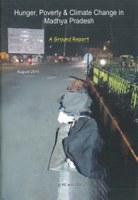 Why hunger speaks the language of death in Madhya Pradesh?
Why hunger speaks the language of death in Madhya Pradesh?
Poverty and Hunger are the biggest challenges not only for the survival of the people but also for the development. Efforts have been made to reduce the crisis, but it is becoming clearer that lack of perspective in the conceptualization of hunger from the people’s point of view and life, the measures taken by the state would not contribute towards meeting the Millennium Development Goals, especially Goal One. We must accept the fact that the Government of India and experts have been trying to set the lowest level of poverty indicators to achieve the Goal of reduction in Poverty and Hunger.
Undernourishment must be described as a situation emerging after lesser calorie consumption as prescribed by the Indian Council of Medical Research (ICMR) and defined as a Recommended Dietary Allowance (RDA) by National Nutrition Monitoring Bureau and National Institute of Nutrition. It has different age faces in different stages of life; we need to categorize the calamity of hunger in different age groups keeping in center. MH Suryanarayana of Indira Gandhi Institute of Development Research in a background paper commissioned by the Planning Commission of India titled Nutritional Norms for Poverty: Issues and Implications (2009), clearly mentions that Calorie consumption is showing decreasing trends from 1972-73. It shows that rural Madhya Pradesh used to consume 2423 Calories in 1972-73, that was at par with the recommended minimum calorie requirement for the rural person but it is constantly declining. Initially, this level of average calorie consumption dropped to 2323 (1983), then 2164 (1993-94), 2062 (1999-00) and in 1929 Calories in 2004-05. It means an individual in rural Madhya Pradesh is not in a position to access the minimum energy requirement.